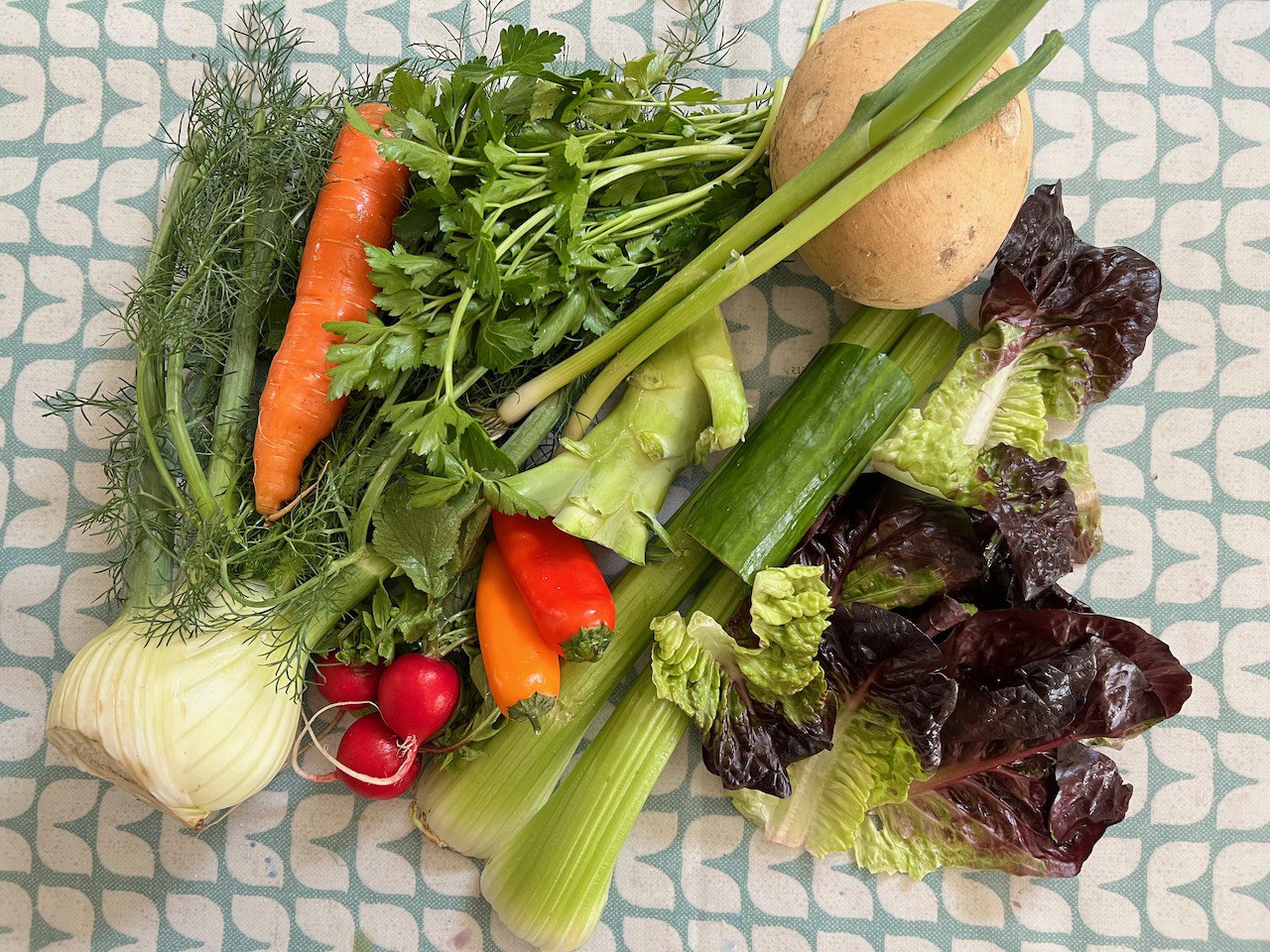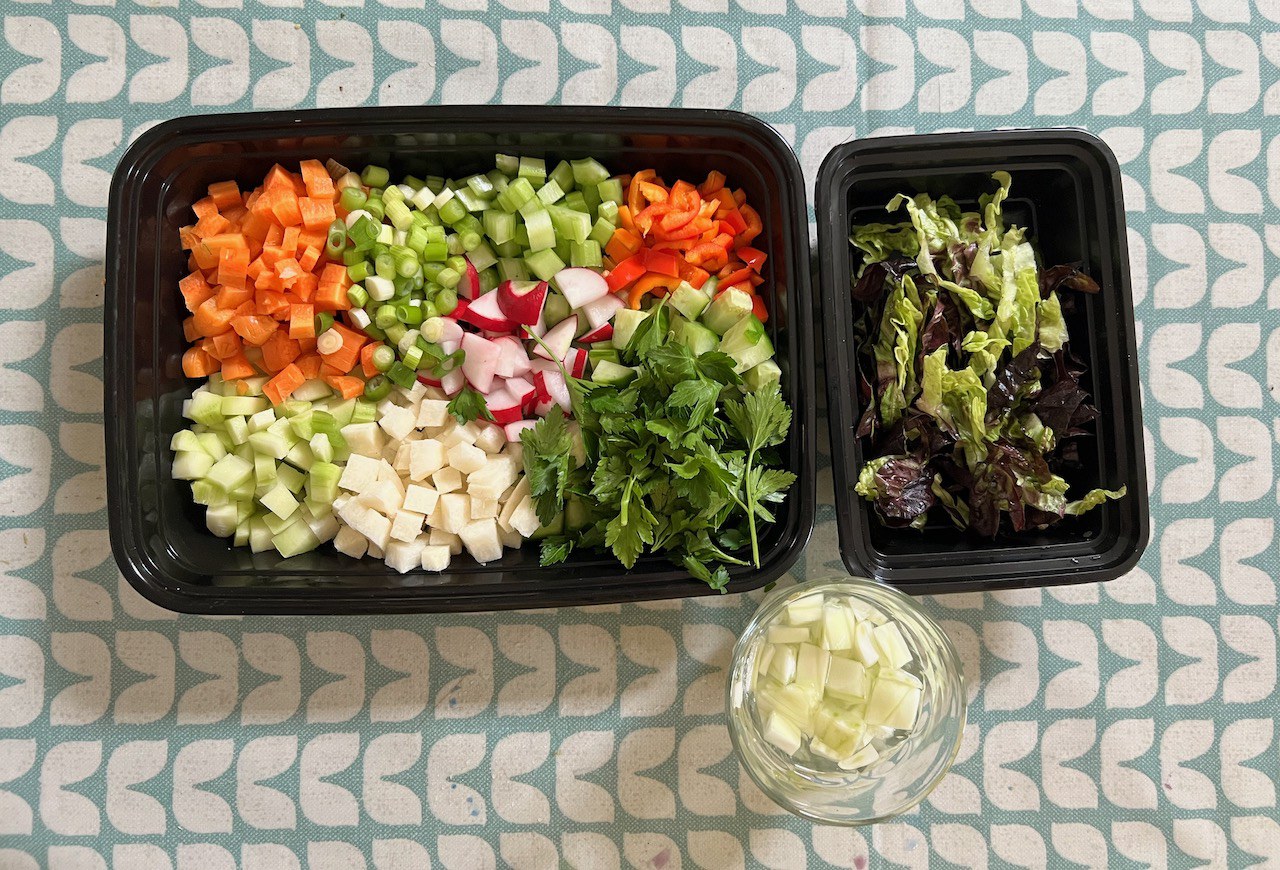I’m clearly not a dieter, nor am I aligned with portion control or shaming how anyone eats. But I do find that after I experience a few days in a row of eating with abandon, my body seems to crave vegetables. We’ve talked about big salads before in the context of TikTok and how they are a constant craze. But I never explored why they’re so popular, in particular the chopped salad variation of the big salad. I love them because there is so much textural interest in a well-made chopped salad. This variety of textures makes for a satisfying and enjoyable eating experience that is never repetitive or boring.
There is crunch, but often not just one kind. There is the crunch that comes from vegetables that are filled with cellulose and water like celery or jicama, and the denser crunch from fennel or peeled broccoli stems. Then there is the crisp crunch that carrots and jicama have. Cucumbers and tomatoes are a hydrating mouthful. Cucumber peel, broccoli stems, and even sweet peppers also have a touch of bitterness which balances the sweet. And of course, each of the vegetables you choose for your salad brings a different flavor to the bowl.

Some choices for a satisfying chopped salad include fennel, carrot, radish, mini peppers, broccoli stem, parsley green onions cucumber, celery, jicama, lettuce. Photo by Evan Kleiman.
Carrots and peppers and cucumber are sweet, celery is salty umami, broccoli is earthy with a hint of sweetness. I like to add a chiffonade of crunchy lettuce like romaine or Little Gem with their mix of sweet and bitter. In addition to crunch, the top of the leaves are soft, which is a welcome change in the mouth. The thin strands of chiffonade once dressed tangle up amidst the chopped ingredients, and act as a kind of binder to help the vegetables stay on your spoon. The variety of flavors in your bowl creates a complex taste that is both interesting and delicious. It’s why so many people can eat chopped salads every day and not tire of them.
Some notes regarding a couple of my choices: I prefer to use mini peppers rather than full-sized bell peppers because their walls are thinner and less likely to “turn” quickly. I only used one layer from the fennel because I didn’t want its characteristic licorice flavor to overpower the salad. Obviously each of us chooses vegetables we prefer in a quantity that feels right to us. I use what I have in the produce drawer which often has more than one use. The remaining fennel can be used for soup or to snack on. The broccoli head attached to the stem becomes a dinner vegetable. You might notice there are no tomatoes. I mostly eat fresh tomatoes in the summer. I use a lot of parsley in soups and in grain salads but I love the leaves whole in a salad.

The veggies are chopped and ready for the salad bowl. Fennel discolors if cut in advance, so it’s good to keep it in water until you need it. Photo by Evan Kleiman.
Once we have the crunch and crisp and spicy vegetables in the bowl, it’s time to choose additions that add richness of mouthfeel and perhaps yield to the bite like avocado, chickpeas, or edamame. The chickpeas and edamame bring protein to the mix. If I don’t plan to eat the salad with a slice of good bread, I’ll often cook a grain to add. My favorites are quinoa for protein and barley or farro for chew.
Yes, there is a fair amount of prep work involved in making a chopped salad which is why so many people prepare enough for several meals at one time. Store everything separately and make sure you use each item up before they go off. Overall, the combination of texture, flavor, healthiness, customizability, and convenience makes chopped salads a popular and appealing choice.
The dressing
It’s all too easy to use a chopped salad as a vehicle to consume mass quantities of dressing. I try to avoid that, but sometimes the metaphorical heart wants what may not be the best for the actual heart. When I have this number of different vegetables in one bowl, I tend to use a vinaigrette rather than a creamy dressing. After all, I'm not interested in masking the flavors of all those vegetables with a heavy blue cheese dressing for example. I’ll save that for a wedge.
Here is my recipe for the dressing my mother made everyday of my childhood. It was the most popular dressing at my restaurant Angeli. It’s a simple mix of extra virgin olive oil and the best red wine vinegar you can find. Its assertive character is created by pushing garlic through a press so it’s super strong. A good quantity of grated Parmigiano Reggiano mellows the garlic just a bit. Salt and freshly ground black pepper finish it off. If you’re using olive oil don’t make the dressing in the blender. The action of the blades causes the oil to become very bitter. I just make it directly in the bowl using my salad spoon as my measuring instrument. But here is the recipe for approximately one and a half cups. Just whisk it in a bowl.
Forte Dressing
Makes approximately 1½ cups
Ingredients
- 2-3 peeled garlic cloves or to taste
- 2 pinches salt
- ⅔ cup extra virgin olive oil or a combination of sunflower and olive oil
- ⅓ cup red wine vinegar
- ¼-½ cup grated Parmigiano Reggiano
Healthy grind of fresh black pepper
Instructions
- Using a garlic press, puree the garlic into the salad or a small mixing bowl.
- Add the salt and mix together with the garlic using the back of a wooden spoon.
- Add oil and vinegar and the grated cheese. Whisk to stir.
Don’t apologize to anyone for your garlic breath.
